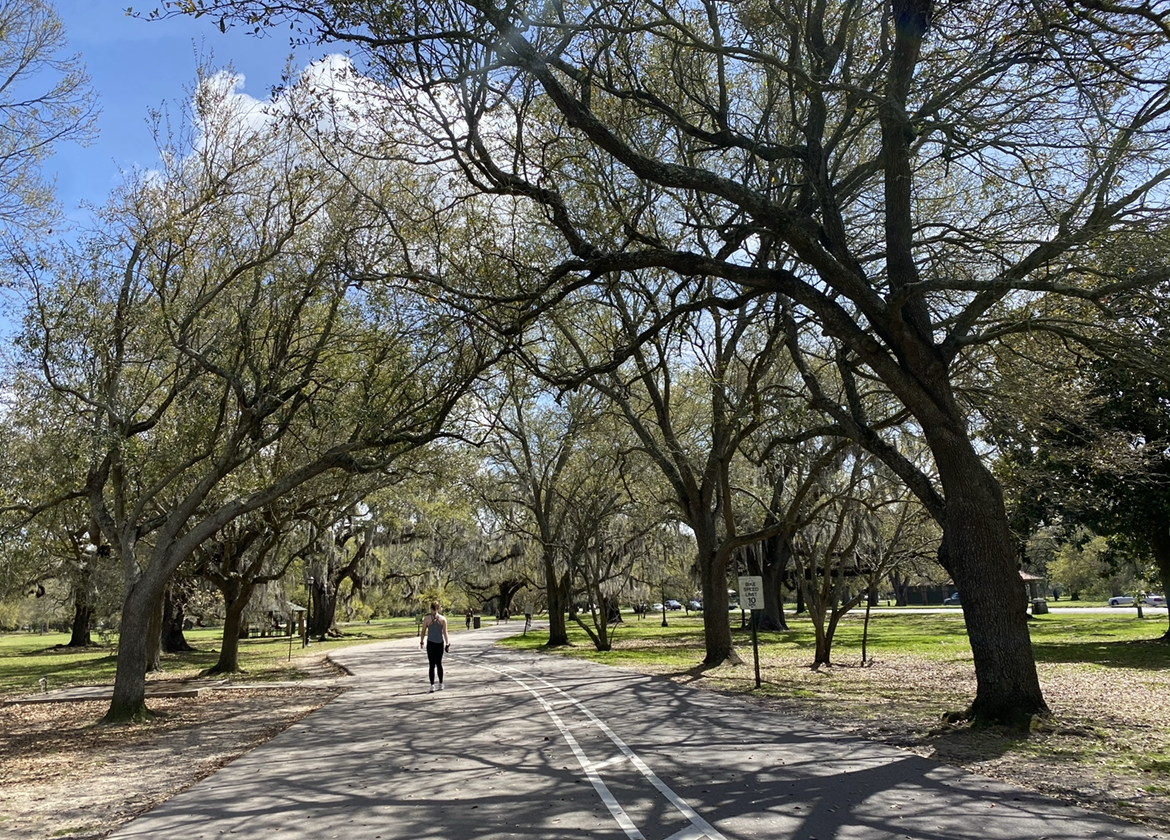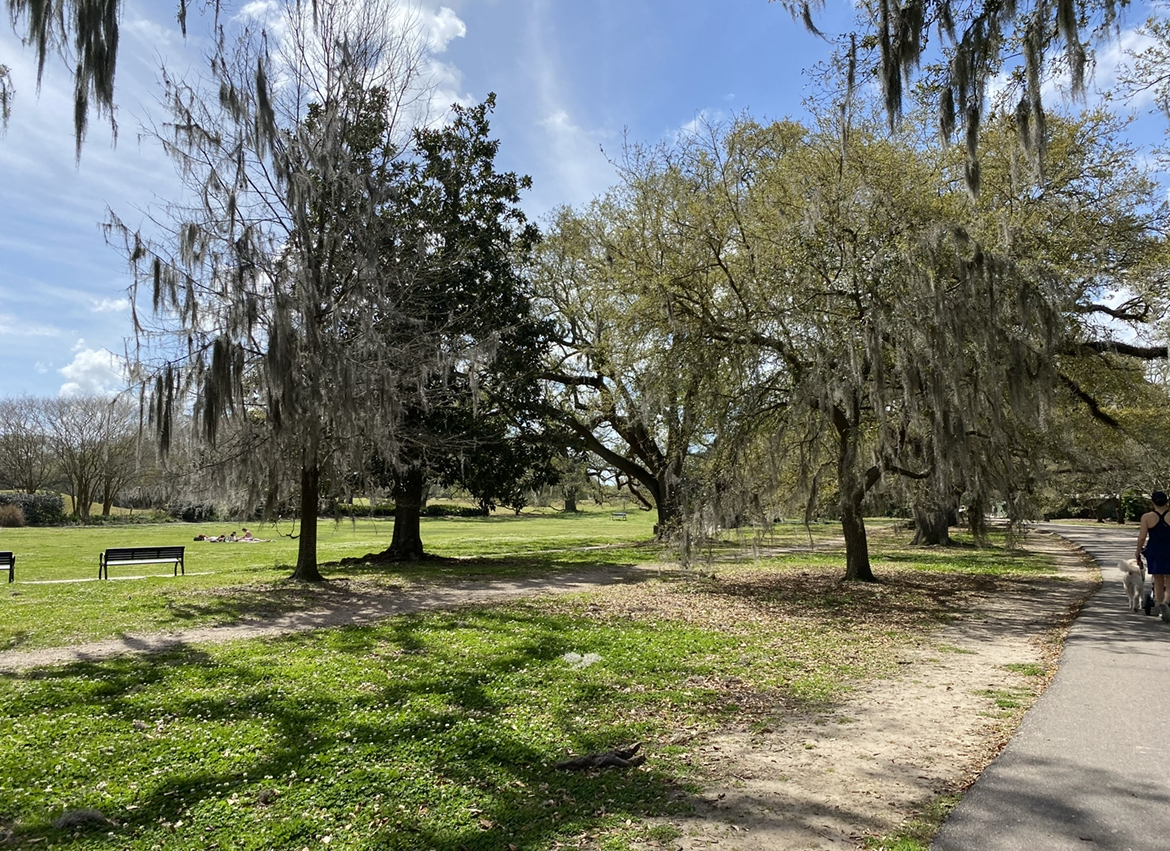I step into Audubon Park and immediately feel a cool breeze brush against my body on an 83 degree May afternoon. Stepping under the 70-foot oak trees provides a shield from the heat. Birds are chirping, people are talking to each other, and there is at least 30 feet of space between myself and the other people in Audubon. I head towards the start of the Audubon loop and prepare myself for the independent journey that I am about to experience over the next 1.8 miles.
Being alone in New Orleans and in college, especially at Tulane, can sometimes be difficult since it is engraved in Tulane culture to spend as much time as we can around friends. Only 61% of college students with stress and anxiety disorders report seeking mental health help, which leaves feelings of loneliness and social isolation. According to Anne Forbes, loneliness can be described as an “unwelcoming feeling” of being alone. When someone socially isolates themself, they are making a conscious decision to spend all of their time alone, while when a person is lonely, they designate time to themself. So, let’s now start with the Audubon Park loop walk that hits the golf course, and assess whether it’s a place to be alone or a place of loneliness.

Trees in Audubon Park linger over the park loop.
The first section: As I start my walk I look up and see the Oak Tree branches dangling down right above my head as the wind blows the leaves. The hundreds of trees stand as tall as a three-story building scattered around the 350-acre park, observing everyone who passes by. The sound of the tires rolling in the bike lane fills the air, along with the distant laugh of a couple a few feet in front of me in the walking lane. The blue sky and the green golf course allow my body to calm down and relax. Although being outdoors, in general, can be a relaxing experience, certain colors and exposures can create a soothing environment and conjure positive thoughts. Color is generally the most relative means of expressing how we feel. The yellow road signs lining the loop allow me to take a clear, deep breath and appreciate my surroundings. As I look down, I see the outlines of walking people painted on with white paint below my feet. The serenity and peace are transparent as my light grey sneakers carry me step by step through the loop. The Audubon Park loop allows for walkers to either power walk or stroll while peacefully experiencing the positive aspects of loneliness. I am able to reflect on my thoughts with a clear head and take in everything Audubon has to offer. My heart rate slows, my muscles relax, and my breathing is at a normal pace. The long loop of Audubon gives time and space for this healing as the loop can take up to an hour to fully experience. Taking time to experience a calm sense of loneliness assists in helping college students release the high anxieties they face on a daily basis such as social pressures and exams. Associating calm feelings while being alone allows students to recognize it is okay to be lonely when you receive the benefits of it since Audubon is a place where loneliness is embraced for its positives.

A sunny day in Audubon Park walking through the loop.
The second section: As I approach the duck pond stretch of the park, about a little over one mile in, the sound of quacking and quiet squeals fill the air. The light brown ducks pack the small pond to the point where the water seems nonexistent. They sit and face each other, unbothered by the rest of the park walking around them. To my right, I see a woman in an all-purple outfit standing in the center of a circle of Great Egret birds with a brown paper bag of torn-up pieces of Wonder Bread in her hand that she is passing out to the birds. Your shoulders drop and you take a deep breath as your body de-tenses itself while trusting the environment you have put yourself in. People generally enjoy being around other people, even if they are not interacting with them. While walking past the duck pond, each bench is filled with people laughing, talking, or quietly keeping to themselves. Opening up to the possibility of emotional connections is essential for eliciting the positives in Audubon. As I continue to walk around the pond, I am able to clear my head and escape from the outside world, while still maintaining those relations with the people near me. A sense of friendliness is present as I exchange ‘hellos’ and smiles with the roller skaters zooming by to my right. Seeing these people fills the desire to fit in and belong with the environment you’re in. Everyone in the park is respectful of the mutual feeling of loneliness and realizes that being lonely allows people to feel more at peace. Walking through this section also allows you vicariously to experience the joy/happiness/peace that the people around you are feeling as well. Observing joy from other people allows you to feel a smile form on your face and the tension released from your body. Watching the laughter resonates with you as you positively empathize with the people around you, causing the loneliness to slowly fade. Being alone isn’t an interruption to everyday life: it’s a time for clarity and to pick on the positive, healthy emotions from those around you in order to fuel your joy.
Finishing up the loop and exiting the park, I take one last deep breath of the fresh park air and look around to see laughter circulating from the fountain, and the groups of children scootering and screaming down St. Charles. The Audubon loop allows people to have the opportunity to choose loneliness. Loneliness can be empowering for so many people when they can choose to be lonely. Being lonely can be isolating if you let it, but if you take charge of personal feelings, it will not. Also, loneliness can lead you to find joy in places you would have never expected. The serenity in the park sparks feelings of calmness, while the familiarity of people brings feelings of vivacious joy while alone. Here I can realize that loneliness isn’t permanent. There are times when it is okay to be lonely and that should be embraced.
 NOLAbeings Multimedia artist Claire Bangser created NOLAbeings as a portrait-based story project that marries...
NOLAbeings Multimedia artist Claire Bangser created NOLAbeings as a portrait-based story project that marries...  Voodoo in New Orleans: Reviving history: New Orleans fortune telling This article takes a deep dive into the history of Voodoo in New Orleans, its hybridization with Catholicism, and its present-day place in the city's culture. The author visits fortune-tellers in the French Quarter, using their guidance as a tool for introspection rather than a deterministic predictor of the future. Through her experiences in New Orleans, the author feels a mystical connection to both the past and the future.
Voodoo in New Orleans: Reviving history: New Orleans fortune telling This article takes a deep dive into the history of Voodoo in New Orleans, its hybridization with Catholicism, and its present-day place in the city's culture. The author visits fortune-tellers in the French Quarter, using their guidance as a tool for introspection rather than a deterministic predictor of the future. Through her experiences in New Orleans, the author feels a mystical connection to both the past and the future. 